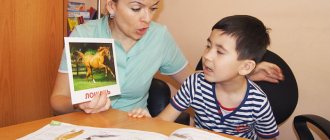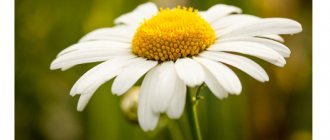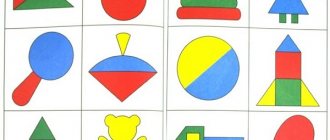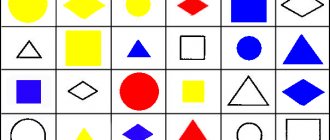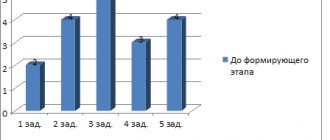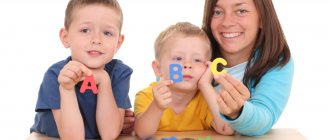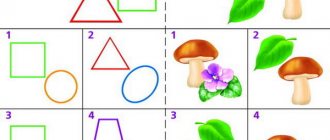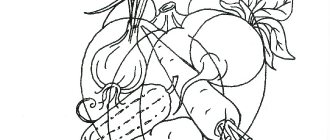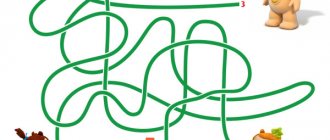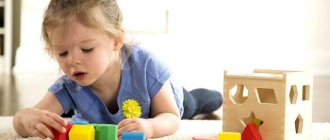Auditory memory is one of the types of figurative memory, thanks to which we capture auditory images, store them and reproduce them.
In preschool age, involuntary memory predominates in children, in which everything that is bright, emotional, interesting, and unusual is remembered “by itself,” without the participation of will and consciousness. Voluntary memory will have to be developed, and this cannot be achieved without some effort. You can read more about voluntary and involuntary memory in our article Involuntary memory and voluntary memory
A developed auditory memory will be the key to a child’s mastery of correct pronunciation of words, intonation of sentences, expressive reading, and spelling. Impaired auditory memory can become a stumbling block when studying the school curriculum, because oral explanations are an important part of mastering the material.
The auditory type of memory, like other types of memory, involves processing information by the brain: its transformation and storage. In the process of listening, sound stimuli are converted into nerve impulses, transmitted to the brain along the auditory nerve, perceived and processed by the brain; The process also includes conscious perception of sounds.
The correct perception of information depends on the ability to determine the source, highlight the main sounds, recognize them, and fill in the missing ones. An error at any stage will fail and lead to incorrect processing of what is heard.
Using various simple tests, you can get an idea of the state of children’s auditory memory, and through games and exercises, you can improve its volume.
If a child fails to complete a test task or exercise, it’s okay. Try to explain differently or explain again. Even if you are irritated or upset, do not show this to your baby. You must be a support and support for him. Many problems and complexes of adults come from childhood, and they are born, among other things, from the fear of being or looking bad, stupid, worse than everyone else, that is, from self-doubt due to the negative reaction of adults, whose opinion the child values. But praising a child for his achievements, even if they are small, is useful. Don't compare him with other children, rather celebrate his own small victories. If you notice that your child is having difficulty constructing sentences correctly, do not be upset or upset the child, but do not delay consultation with a specialist (speech pathologist-speech pathologist).
Auditory memory disorders
It happens that a child experiences difficulties in perceiving speech, when isolating it from the surrounding noise, cannot immediately understand tasks and commands received orally, when mastering new words or learning languages. These problems may not be related to attention deficits or lack of motivation, and may not be the result of bad behavior. Perhaps the reason lies in auditory neurological disorders. Disorders of auditory processing may be associated with traumatic brain injury, long-term inflammation of the middle ear, birth trauma, and other causes. In such cases, consultation with a specialist is necessary. Treatment, as a rule, includes several areas: improving cognitive and speech skills, improving the perception of auditory information, improving the quality of the auditory signal.
Memory value up to 7 years
Scientists have developed many definitions for memory. But everyone recognizes that this is a complex mental process. Memory is the ability of a child and an adult to receive life experience, retain it and reproduce it.
The life experience of a preschooler includes everything that surrounds him, everything he encounters. Memory develops rapidly up to 7 years of age. This is the so-called natural memory.
A preschooler remembers when he sees an unfamiliar picture or object.
If he saw something out of the ordinary, he begins to talk, remembering something similar from his experience. The thinking of a small child consists of memory, of his life experience.
Therefore, as rich and varied the experience is, so full and strong will be his natural memory.
By the way, the speed of its development cannot be compared with the development of the child’s other abilities. She is the tallest. This is achieved through the ideal interaction of both hemispheres of the brain.
Why are children geniuses from birth? Because up to 3 they have this amazing synchronicity. And those adults who own it are considered geniuses.
What is the minimum you can do to be calm about your child’s future, read our book and get the most effective games.
For the most physiological method of development from birth, follow this link (will open in a new tab).
Diagnostics of auditory memory
There are various methods for diagnosing auditory memory that make it possible to accurately determine its condition at the everyday level.
“10 Words” Methodology by A.R. Luria
This technique is often used as a rapid diagnosis of auditory memory. The results obtained make it possible to assess the level of development of auditory memory, auditory attention, fatigue, and the level of phonemic hearing. This auditory memory test is used both for children of middle preschool age and for adults.
Prepare words in advance, for example: table, hare, mirror, tree, wall, fly, feather, star, bird, notebook. Ask your child to listen and memorize this series, and then read the words at intervals of 1-2 seconds. Let him reproduce all the words that he managed to remember.
Repeat reading and playing three times, record those words that were memorized. For the fourth time, the child must remember and repeat all the words in random order after 20-30 minutes.
Results: if a child remembers 4-6 words after the first reading, this is a normal result. If you remember less, but other words were included in the answer, perhaps there is a low level of auditory attention.
If you remember less, but replace some sounds, your phonemic perception may be impaired.
The second and third reproduction after reading is an indicator of the child’s memorization speed and fatigue.
The fourth reproduction is an indicator of the volume and level of development of long-term memory. The norm is if the child can reproduce two words more or less than the best result after the first three attempts.
A simplified version of the Luria Auditory Memory Test
Repeat a series of 10 words up to 7 times until either the subject remembers all the words, or a decision is made to interrupt the auditory memory test.
It is considered normal if a person remembers at least 5 words after the first reading. By the fifth repetition, all 10 words should be memorized.
Diagnostics of RAM (Wechsler “Counting” subtest)
Stage 1: the subject is given 3 numbers and asked to repeat them, then 4 numbers, then five, etc., and so on until the first error.
Stage 2: the same task (repeat the named numbers), but only “back to front”, starting with the last one, that is, in reverse order.
The norm is to memorize 5-9 digits when counting forward and at least 5 when counting backwards.
"Remember two-digit numbers"
This method of diagnosing auditory memory is suitable for children of middle and high school age and for adults.
Prepare 12 two-digit numbers. For example, a set of numbers could be: 22, 17, 43, 21, 14, 49, 56, 71, 86, 15, 61, 76.
Warn your child that he will need to listen and remember the numbers, and then, after the signal, write down all the numbers that he can remember, in random order, for 30 seconds. Results: the result is considered good if the subject remembers 7 numbers.
Diagnostics of auditory memory using literary texts
In order to test auditory memory, you need to select a short plot text consisting of 10 - 12 simple sentences. This could be, for example, a short story, a fairy tale, a fable for children, and a more complex informative story for adults. The text is read legibly, not too quickly, expressively. Then it is played back to the subject for the first time immediately after listening, and again an hour after that. The norm is the correct presentation of the plot and 1-2 errors on the first playback, and up to 3-4 errors on the second.
There are other, more complex tests that examine auditory and other types of memory, but their use requires the skills and knowledge of psychologists to examine and interpret the results in more detail. Such tests are usually carried out in specialized institutions.
Definition
Auditory memory is a form of sensory perception of information for subsequent storage and use. Synonyms for auditory are echoic and auditory memory. Information received through the hearing organs is stored with high accuracy within a few seconds.
This type of memory is resistant to damage resulting from damage to the brain matter. Usually, in severe forms of amnesia, the ability to perceive and remember information by ear is preserved. It is impossible to simultaneously detect a large number of sound stimuli so that they are distinguishable.
Echoic memory reflects the ability to perceive the full variety of sound stimuli that are reproduced in the external environment. The volume of short-term and long-term auditory memory largely depends on the individual characteristics of a person and genetic factors. Examples of auditory memory:
- Repeat the phone number you just heard.
- Recreate in your mind the name of the person you just met.
- Answer the question that was just asked.
As with any other type of memory, the auditory form typically involves selective memorization of information that is associated with strong emotions, arouses interest, and provokes the emergence of feelings. Developed auditory perception determines good learning ability with the help of oral explanations and verbal instructions. Those with good auditory memory better and faster master the skills of orthoepy (exemplary literary pronunciation), the rules of speech intonation, and develop the expressiveness of speech structures.
Exercises to develop auditory memory
A child cannot do without the help of adults for the successful development of auditory memory. Reading poems, proverbs and sayings aloud clearly, slowly and expressively, or listening to age-appropriate audiobooks is a good step in this direction. And if a child retells the passage read after ten minutes of reading, this will already be a real exercise for the development of the child’s auditory memory. Even just when dressing your child, accompany your actions with words. This way the baby will learn to compare sounds and actions.
Exercises for kids should be turned into games, because this is how children most willingly absorb new knowledge.
— Game “10 pairs”
This game helps improve concentration and auditory memory. Come up with 10 pairs of words that are related in meaning in advance. For example: shoes - laces, telephone - beep, rain - cloud, plum - compote, pen - notebook, orange - lemon, candy - cookies, bear - den, hedgehog - needles, house - roof. Read them to your child three times, take your time, speak expressively, emotionally, with intonation. And for the fourth time, read only the first words, and let the child remember and name the second word or pair for each of them.
— Game “Do as I do”
You will need: paper; two glasses, one of which is filled with water; 2 spoons; hammer; bell. Ask your child to close his eyes. After this, perform 3-4 sound actions with the prepared objects. For example, pour water from glass to glass several times; clink the spoons together; stir the water in the glass with one of the spoons; rustle the paper, tap the spoon on an empty or full glass.
After this, ask the child to open his eyes, remember the sounds and repeat them from memory.
- Game “Guess what it was?”
Prepare several recordings (for example, use a voice recorder or find suitable recordings on the Internet). For example, this could be the sound of the wind, the roar of the surf, the crackling of wood in a fire, the singing of birds, the sound of rain, the sound of thunder, the sound of applause, the rustling of a wrapper when unwrapping candy, the crunch of crackers, and so on. Ask your child to guess what it was. Ask him to try to repeat it, play with him, make digressions from the game, telling something interesting about these sounds and phenomena.
— Game “Remember and complete”
This game will help increase your auditory memory. The presenter can start, for example, like this: “I put a book in my briefcase.” The second player must repeat this phrase and add his word. For example, like this: “I put a book and a flashlight in my briefcase.” Each time the next player must repeat everything that was named before him and add his own word. If there are many players, the one who gets confused leaves the game, and if there are few, he gets one point. If you score three points, you become an observer. Start options may vary. For example:
“Today I saw outside the window...”;
“My friend has in his room...”
“Behind a high fence they kept...”
“Masha had in her basket...”
- Variant of the same game:
Begin any sentence. For example: “Masha went out into the clearing and saw...” Let the child repeat what he heard and continue. For example: “Masha went out into the clearing and saw a small hut...”. Then follow the same principle: the next player repeats and complements. For example: “Masha went out into the clearing and saw a small hut with strawberries growing around it...”. Keep memorizing and composing until someone fails. This game also helps to increase the volume of auditory memory, but, in addition, develops imagination.
— Game “Feel the Rhythm”
Tap a simple rhythm with your fingertips or the back of a pencil and ask your child to repeat it. Alternatively, you can tap out the rhythm by clapping your palms.
— Game “Guess the ending”
This exercise for developing auditory memory is intended primarily for preschool children. Read short children's poems to your child, but do not say the last word. Let the child guess and name it himself. This is very useful, because the child will have to use vocabulary, rely on logic, take into account rhythm and consonance (rhyme).
More tips and exercises for developing auditory memory can be found in our article Auditory Memory. Development of auditory memory. And the game “Zvukvar”, the link to which you will find here, is intended specifically for training auditory memory.
Memory develops best if it is frequently used and stimulated. More information about short-term memory and its development can be read in our article Short-term memory - what is it? How to develop short-term memory? In addition, you can develop memory in different ways. It is very convenient to use memory training exercises for this purpose.
We wish you pleasant caring for your child and, of course, success in self-development!
Musical memory
The process of memorizing musical works is musical memory. It is a component of musical ability, which supports skills such as a sense of rhythm and an ear for music. In addition to the musical work itself, information is stored in memory that conveys the emotional state of a person at the moment of listening or playing music.
To develop musical memory, a method such as vocal reproduction of a composition without the use of an instrument is used, which allows you to better remember the melody, relying on auditory perception. If you need to memorize a large piece of music, you should break it into fragments and master it gradually. Mental repetition of the melody concentrates attention on auditory images.
In classes with preschoolers, they do musical exercises that involve the child vocally repeating the melody he has heard. It is important that the child conveys the rhythmic pattern, tempo, and character of the sound. To improve their ear for music, they memorize and constantly sing their favorite songs, conveying not only the exact text, but also the slightest sound nuances of the original performance.
Do you already know what types of attention there are?
Depending on the participation of the will, there are:
- voluntary attention
- involuntary attention
Voluntary attention is attention when a child consciously and purposefully pays attention to some object and maintains attention on it for a certain time.
Involuntary attention is attention that arises against the will of the child, on its own; it practically cannot be consciously regulated by it.
This is attention to a loud sound, a flash of light, or some unusual or disgusting smell.
It was suggested that there is still post-voluntary attention, as an independent type of attention that arises some time after a person voluntarily maintains attention on some object.
So, after a while, it is no longer necessary to exert an effort of will in order to maintain attention on this object.
However, later scientists came to the conclusion that this involves a transition from voluntary to involuntary attention and does not form an independent type.
Depending on the use of special means for managing attention, the following are distinguished:
- direct attention is the attention attracted by the object itself that is interesting to a person, without the use of any additional means.
- indirect attention is attention that arises and is controlled through additional means, indirectly related or not related to the object itself. For example, by using symbols (an arrow pointing to an object), words (you can say, for example, “pay attention...” or “look”).
The most important type of attention to develop
This, of course, is voluntary attention. What do you need to know about its development in a child?
From birth, the child has direct and involuntary attention.
By the end of the first year of life, the prerequisites for the future development of voluntary attention appear, he begins not only to react, but also to do something independently at will, he directs his activity to what interests him.
He tries to do something, take it out, examine it, taste it, throw it, throw it away)
At 2-3 years of life , reactive voluntary attention develops, arising under the influence of an adult’s speech, his facial expressions, gestures, as well as under the influence of the direction of the child’s gaze at the named object.
The child himself begins to use these means to attract other people.
4.5-5 years is the beginning of active voluntary and mediated attention. A child can direct his attention to some object when an adult draws his attention to it, under the influence of complex speech instructions.
The child begins to control his own attention (drawings, signs).
By the age of 5-6 years, under the influence of independent instructions, the child develops elementary forms of voluntary attention; he can describe what he is doing out loud, and this speech guides his attention.
It has a small volume and is not yet quite unstable.
Junior schoolchildren. At this age, further development of voluntary and indirect attention occurs. But it lags behind the attention of an adult in all respects: stability, distribution, concentration, switchability and volume.
Only by adolescence does the level of development of attention reach that of an adult.
In games we will develop just these properties of attention:
- stability - the ability to remain at a certain level for a long time
- distribution - the ability to split into several tasks at once
- concentration - the ability to concentrate on one thing, thought, image and distract attention from everything else
- switchability - switching from one object to another (speed or speed)
- volume - the maximum number of objects held simultaneously
What you need to know about memory development in children from birth, preschoolers and up to 10 years old
From birth, the right hemisphere of the brain is dominant in the child. It is precisely this that is associated with involuntary memorization. Thus, scientists have proven that both hemispheres are also involved in memorizing verbal information.
However, involuntary memorization is provided by the right hemisphere, and voluntary, higher level of mnestic activity is provided by the left.
The right hemisphere gives figurative-emotional and visual-visual memory to our children, and the left hemisphere gives memory for words, numbers, and formulas. The memory of a child under 6 years of age is involuntary.
Until the age of 3, he can remember without even wanting to. We all know children who can recite entire poems, long poems, by heart. Their memory is a sponge.
From the age of three, the left hemisphere begins to come into play in children. “I” appears and his memory begins to be selective, depending on his interests, brightness, emotionality, just like an adult)
The dominance of the left hemisphere finally occurs by the age of 6-10 (according to our scientists, 9-10 years), and the right hemisphere, with its phenomenal figurative memory and imagination, loses its position.
Therefore, if the abilities for which the right hemisphere is responsible have not been developed, they disappear or fade. And with kids, we practice Makoto Shichida’s method as early as possible in order to develop the abilities of the right hemisphere.
As for voluntary memorization, for which the left hemisphere is responsible, then:
- at 5-6 years old the first signs of this memorization begin to appear
- by 6-7 years it is already fully formed
- by 6-7 years old can consciously use its logical connections when memorizing material
To use voluntary memorization, the child must want to remember, and here the motivation and participation of parents plays a big role. It should be fun, interesting, easy for children.
Thus, the period from birth to school is a period of involuntary memory, which is associated with the right creative hemisphere of the brain.
At this time, both hemispheres are active and this is the most wonderful period for synchronizing their work, in a different way, for creating strong connections between the hemispheres and the development of the brain as a whole.
And by developing the right hemisphere, we develop the entire brain. Remember Saunière's words?
